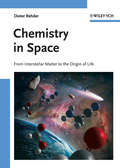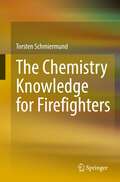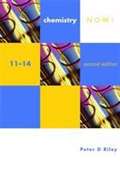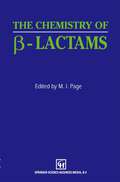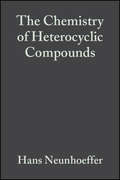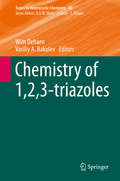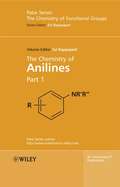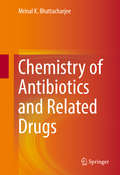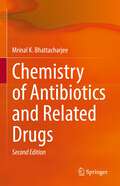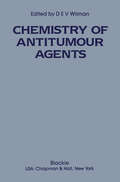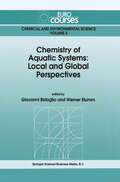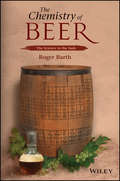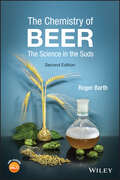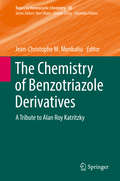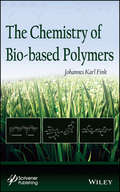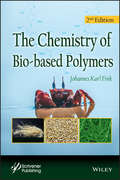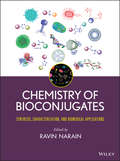- Table View
- List View
Chemistry in Space: From Interstellar Matter to the Origin of Life
by Dieter RehderThe dynamic field of extraterrestrial chemistry brings together ideas of chemistr, astrophysics, and biology to the study of molecules between stars, around stars, and on plantes. This book serves as an introduction to chemial processes under ?unearthly? and hence usually extreme conditions (temperature, pressure, high or low density, bombardment by cosmic rays), and their impact on the early development of our solar system, as well as providing a deeper understanding of processes in earthly regions where conditions approach those of extraterrestrial areas. A unique and extraordinary perspective written with chemists in mind. An excellent practical book for inorganic, and physical chemists, spectroscopists, astronomers, and libraries. From the contents: * Introduction and technical notes * Origin and development of the universe * Stars * The interstellar medium * The solar system * Exoplanets * The origin of life
Chemistry in Space: From Interstellar Matter to the Origin of Life
by Dieter RehderThe dynamic field of extraterrestrial chemistry brings together ideas of chemistr, astrophysics, and biology to the study of molecules between stars, around stars, and on plantes. This book serves as an introduction to chemial processes under ?unearthly? and hence usually extreme conditions (temperature, pressure, high or low density, bombardment by cosmic rays), and their impact on the early development of our solar system, as well as providing a deeper understanding of processes in earthly regions where conditions approach those of extraterrestrial areas. A unique and extraordinary perspective written with chemists in mind. An excellent practical book for inorganic, and physical chemists, spectroscopists, astronomers, and libraries. From the contents: * Introduction and technical notes * Origin and development of the universe * Stars * The interstellar medium * The solar system * Exoplanets * The origin of life
The Chemistry Knowledge for Firefighters
by Torsten SchmiermundChemical facts taught in firefighting training courses are often "isolated facts." In the book, these facts are integrated into an overall chemical-physical concept. Backgrounds are illuminated, and connections can be recognized. The overall understanding is facilitated, tactical measures for the operation become "logical".This book is a translation of the original German 1st edition Das Chemiewissen für die Feuerwehr by Torsten Schmiermund, published by Springer-Verlag GmbH Germany, part of Springer Nature in 2019. The translation was done with the help of artificial intelligence (machine translation by the service DeepL.com). A subsequent human revision was done primarily in terms of content, so that the book will read stylistically differently from a conventional translation. Springer Nature works continuously to further the development of tools for the production of books and on the related technologies to support the authors.
Chemistry now!: 11-14 (PDF)
by Peter RileyChemistry Now! 11-14 is one of three Pupil's Books that cover the requirements of the National Curriculum for science at Key Stage 3, the Common Entrance Examination at 13+ syllabus and equivalent junior science courses.
Chemistry now!: 11-14 (PDF)
by Peter RileyChemistry Now! 11-14 is one of three Pupil's Books that cover the requirements of the National Curriculum for science at Key Stage 3, the Common Entrance Examination at 13+ syllabus and equivalent junior science courses.
The Chemistry of β-Lactams
by M. I. PageIt is over sixty years since Alexander Fleming observed antibiosis between a Penicillium mould and bacterial cultures and gave the name penicillin to the active principle. Although it was proposed in 1943 that penicillin (1) contained a tJ-Iactam ring, this was not generally accepted until an X-ray crystallographic determination of the structure had been completed. RCONH )=r)< o '" (I) 'C0 H 2 Penicillin was the first naturally occurring antibiotic to be characterised and used in clinical medicine. It is now seen as the progenitor of the tJ-Iactam family of antibiotics, which are characterised by the possession of the four membered tJ-Iactam ring. Chapters in this book will describe how current research has demonstrated that other lactam structures may also show antibacterial activity. Penicillins and cephalosporins (2), the second member of the tJ-Iactam antibiotic family, were both originally discovered in fungi but later detected in streptomycetes. Until 1970 penicillins and cephalosporins were the only examples of naturally occurring tJ-Iactam antibiotics. The discovery of 7-a-methoxy cephalosporins (3) from Streptomyces in 1971 stimulated the search for novel tJ-Iactam antibiotics from microbes, both by using sensitive new screening procedures, and by laboratory synthesis.
The Chemistry of 1,2,3-Thiadiazoles (Chemistry of Heterocyclic Compounds: A Series Of Monographs #62)
by Vasiliy A. Bakulev Wim Dehaen1,2,3-Thiadiazoles are a group of heterocycles whose derivatives are important in industry, medicine, and agriculture. This volume provides a complete treatment of this group of heterocycles with an emphasis on syntheses, structural data, properties, reactions, and applications.
Chemistry of 1 2 3-Triazines and 1 2 4-Triazines, Tetrazines, and Pentazin (Chemistry of Heterocyclic Compounds: A Series Of Monographs #108)
by Hans Neunhoeffer Paul F. WileyThe Chemistry of Heterocyclic Compounds, since its inception, has been recognized as a cornerstone of heterocyclic chemistry. Each volume attempts to discuss all aspects – properties, synthesis, reactions, physiological and industrial significance – of a specific ring system. To keep the series up-to-date, supplementary volumes covering the recent literature on each individual ring system have been published. Many ring systems (such as pyridines and oxazoles) are treated in distinct books, each consisting of separate volumes or parts dealing with different individual topics. With all authors are recognized authorities, the Chemistry of Heterocyclic Chemistry is considered worldwide as the indispensable resource for organic, bioorganic, and medicinal chemists.
Chemistry of 1,2,3-triazoles (Topics in Heterocyclic Chemistry #40)
by Wim Dehaen Vasiliy A. BakulevThe series Topics in Heterocyclic Chemistry presents critical reviews on present and future trends in the research of heterocyclic compounds. Overall the scope is to cover topics dealing with all areas within heterocyclic chemistry, both experimental and theoretical, of interest to the general heterocyclic chemistry community. The series consists of topic related volumes edited by renowned editors with contributions of experts in the field.
The Chemistry of Anilines, Part 1 (Patai's Chemistry of Functional Groups #169)
by Zvi RappoportAniline is the parent molecule of a vast family of aromatic amines. Since its discovery in 1826 it has become one of the hundred most important building blocks in chemistry. Aniline is used as an intermediate in many different fields of applications, such as isocyanates, rubber processing chemicals, dyes and pigments, agricultural chemicals and pharmaceuticals. The understanding of functional groups is key for the understanding of all organic chemistry. In the tradition of the Patai Series, this volume treats all aspects of this functional group. It contains chapters on the theoretical and computational foundations; on analytical and spectroscopical aspects with dedicated chapters on Mass Spectrometry, NMR, IR/UV, etc.; on reaction mechanisms; on applications in syntheses.
Chemistry of Antibiotics and Related Drugs
by Mrinal K. BhattacharjeeThis textbook discusses how the various types of antibiotics and related drugs work to cure infections. Then it delves into the very serious matter of how bacteria are becoming resistant to these antibiotics. Appropriate for a one-semester course at either the graduate or advanced undergraduate level, this textbook contains worked examples of (1) experimental procedures and (2) interpreting data.
Chemistry of Antibiotics and Related Drugs
by Mrinal K. BhattacharjeeThis textbook builds on the success of the earlier edition, offering alternative strategies for discovering new antibiotics. It discusses how the various types of antibiotics and related drugs work to cure infections. Then it delves into the very serious matter of how bacteria are becoming resistant to these antibiotics. It also covers the global action plan on antimicrobial resistance from the World Health Organization and discusses several Antibiotic Stewardship Programs adopted by agencies at local levels. Appropriate for a one-semester course at either the graduate or advanced undergraduate level, the book is self-contained and written in accessible language. It includes all necessary background biochemistry material and a discussion of the latest developments in the field of antibiotics. Original research works are frequently cited and experimental procedures and interpretation of results are emphasized.
The Chemistry of Antitumour Agents
by D.E. WilmanWalter C. J. ROSS Emeritus Professor, University of London To paraphrase a statement made by Howard E. Skipper many years ago, 'We cancer chemotherapists have often exploited and overworked our chemist colleagues and they have been conveniently forgotten at award giving times'. This book is an attempt to rectify this and highlight the contribution of the chemist in modifying the structure of various types of agent to enhance their effectiveness as inhibitors of the growth of neoplastic tissues. Cancer chemotherapy is a relatively new discipline, coming later than the introduction of sulphonamides and antibiotics. Modern anti-cancer therapy started with the report of the use of a war gas methyl-di-(2-chloroethyl)amine (HN2) in 1946 for the treatment of Hodgkin's disease. The recognition that this compound acted as a bifunctional alkylating agent under physiological conditions led to the synthesis of a wide range of drugs with similar properties. Amongst these were chlorambucil, melphalan, busulphan, and cyclophos phamide which still find use today. Somewhat later, a range of antibiotics was found to be effective, for example aminopterin (1948) and 6-mercaptopurine (1958) to treat acute leukaemias and 5-fluorouracil and 6-azauracil (1957-8) which were used against a variety of cancers. Since these early days the net has been cast ever wider and, as well as ingenious modifications of the compounds mentioned above, anticancer drugs now include growing classes of compounds ranging from purely synthetic agents to natural products. Many of these are discussed in the present book.
Chemistry of Aquatic Systems: Local and Global Perspectives (Eurocourses: Chemical and Environmental Science #5)
by Giovanni Bidoglio Werner StummAquatic systems play a salient role in the complex processes of energy and matter exchange between the geosphere and the atmosphere. For example, reactions taking place in cloud water droplets can substantially alter the atmospheric budget and chemistry of trace gases; pollution induced weathering reactions at water/soil interfaces can affect the availability of nutrients and increase the concentration of potentially toxic metals in groundwaters. Moreover, the inextricable links between the water cycle, the geosphere and the atmosphere ensure that apparently localized environmental problems have increasingly impacts in other parts of the world. To identify local-to-global scale variables associated with environmental changes, a focus must be placed on the recognition of processes, rather than a continued reliance on monitoring state variables. However, in heterogeneous aquatic systems, small scale aspects of a process under observation may not be summed directly to obtain regional estimates because of process nonlinearities with change in scale. To understand this, the integrated use of measurements across a range of scales is required.
The Chemistry of Beer: The Science in the Suds
by Roger BarthDiscover the science of beer and beer making Ever wondered just how grain and water are transformed into an effervescent, alcoholic beverage? From prehistory to our own time, beer has evoked awe and fascination; it seems to have a life of its own. Whether you're a home brewer, a professional brewer, or just someone who enjoys a beer, The Chemistry of Beer will take you on a fascinating journey, explaining the underlying science and chemistry at every stage of the beer making process. All the science is explained in clear, non-technical language, so you don't need to be a PhD scientist to read this book and develop a greater appreciation for the world's most popular alcoholic drink. The Chemistry of Beer begins with an introduction to the history of beer and beer making. Author Roger Barth, an accomplished home brewer and chemistry professor, then discusses beer ingredients and the brewing process. Next, he explores some core concepts underlying beer making. You'll learn chemistry basics such as atoms, chemical bonding, and chemical reactions. Then you'll explore organic chemistry as well as the chemistry of water and carbohydrates. Armed with a background in chemistry principles, you'll learn about the chemistry of brewing, flavor, and individual beer styles. The book offers several features to help you grasp all the key concepts, including: Hundreds of original photographs and line drawings Chemical structures of key beer compounds Glossary with nearly 1,000 entries Reference tables Questions at the end of each chapter The final chapter discusses brewing at home, including safety issues and some basic recipes you can use to brew your own beer. There's more to The Chemistry of Beer than beer. It's also a fun way to learn about the science behind our technology and environment. This book brings life to chemistry and chemistry to life.
The Chemistry of Beer: The Science in the Suds
by Roger BarthDiscover the science of beer and beer making Ever wondered just how grain and water are transformed into an effervescent, alcoholic beverage? From prehistory to our own time, beer has evoked awe and fascination; it seems to have a life of its own. Whether you're a home brewer, a professional brewer, or just someone who enjoys a beer, The Chemistry of Beer will take you on a fascinating journey, explaining the underlying science and chemistry at every stage of the beer making process. All the science is explained in clear, non-technical language, so you don't need to be a PhD scientist to read this book and develop a greater appreciation for the world's most popular alcoholic drink. The Chemistry of Beer begins with an introduction to the history of beer and beer making. Author Roger Barth, an accomplished home brewer and chemistry professor, then discusses beer ingredients and the brewing process. Next, he explores some core concepts underlying beer making. You'll learn chemistry basics such as atoms, chemical bonding, and chemical reactions. Then you'll explore organic chemistry as well as the chemistry of water and carbohydrates. Armed with a background in chemistry principles, you'll learn about the chemistry of brewing, flavor, and individual beer styles. The book offers several features to help you grasp all the key concepts, including: Hundreds of original photographs and line drawings Chemical structures of key beer compounds Glossary with nearly 1,000 entries Reference tables Questions at the end of each chapter The final chapter discusses brewing at home, including safety issues and some basic recipes you can use to brew your own beer. There's more to The Chemistry of Beer than beer. It's also a fun way to learn about the science behind our technology and environment. This book brings life to chemistry and chemistry to life.
The Chemistry of Beer: The Science in the Suds
by Roger BarthThe Chemistry of BEER An Engaging Introduction to Chemistry with a Popular Theme From the earliest civilizations to our own day, brewing beer has driven science and technology. In ancient times, brewing was the most advanced biotechnical process. In the modern world, the study of alcoholic fermentation was the springboard for the new science of biochemistry. The Chemistry of Beer: The Science in the Suds, 2nd Edition explains the scientific basis of each brewing step as we understand it today. Readers of this second edition will find: Updates and revisions include a new chapter on beer-related products such as hard seltzer, flavored malt beverages, and non-alcoholic beer Streamlined language and structure to help clarify the chemistry Over 200 illustrations, now in full color throughout Complete glossary and index Question sets at the end of each chapter to check for understanding Online solutions manual on a companion website for professors The Chemistry of Beer: The Science in the Suds, 2nd Edition is designed to engage students in an introductory chemistry course. Optional material extends the level to make it a useful supplement for a brewing science course. The material and style of presentation will interest brewing professionals, others in the beverage industry, advanced homebrewers, and beer enthusiasts.
The Chemistry of Beer: The Science in the Suds
by Roger BarthThe Chemistry of BEER An Engaging Introduction to Chemistry with a Popular Theme From the earliest civilizations to our own day, brewing beer has driven science and technology. In ancient times, brewing was the most advanced biotechnical process. In the modern world, the study of alcoholic fermentation was the springboard for the new science of biochemistry. The Chemistry of Beer: The Science in the Suds, 2nd Edition explains the scientific basis of each brewing step as we understand it today. Readers of this second edition will find: Updates and revisions include a new chapter on beer-related products such as hard seltzer, flavored malt beverages, and non-alcoholic beer Streamlined language and structure to help clarify the chemistry Over 200 illustrations, now in full color throughout Complete glossary and index Question sets at the end of each chapter to check for understanding Online solutions manual on a companion website for professors The Chemistry of Beer: The Science in the Suds, 2nd Edition is designed to engage students in an introductory chemistry course. Optional material extends the level to make it a useful supplement for a brewing science course. The material and style of presentation will interest brewing professionals, others in the beverage industry, advanced homebrewers, and beer enthusiasts.
The Chemistry of Benzotriazole Derivatives: A Tribute to Alan Roy Katritzky (Topics in Heterocyclic Chemistry #43)
by Jean-Christophe M. MonbaliuThe series Topics in Heterocyclic Chemistry presents critical reviews on present and future trends in the research of heterocyclic compounds. Overall the scope is to cover topics dealing with all areas within heterocyclic chemistry, both experimental and theoretical, of interest to the general heterocyclic chemistry community. The series consists of topic related volumes edited by renowned editors with contributions of experts in the field. All chapters from Topics in Heterocyclic Chemistry are published Online First with an individual DOI. In references, Topics in Heterocyclic Chemistry is abbreviated as Top Heterocycl Chem and cited as a journal.
The Chemistry of Bio-based Polymers
by Johannes Karl FinkAn exhaustive and timely overview of renewable polymers from a respected chemist and successful author The recent explosion of interdisciplinary research has fragmented the knowledge base surrounding renewable polymers. The Chemistry of Bio-based Polymers brings together, in one volume, the research and work of Professor Johannes Fink, focusing on biopolymers that can be synthesized from renewable polymers. After introducing general aspects of the field, the book’s subsequent chapters examine the chemistry of biodegradable polymeric types sorted by their chemical compounds, including the synthesis of low molecular compounds. Various categories of biopolymers are detailed including vinyl-based polymers, acid and lactone polymers, ester and amide polymers, carbohydrate-related polymers and others. Procedures for the preparation of biopolymers and biodegradable nanocomposites are arranged by chemical methods and in vitro biological methods, with discussion of the issue of “plastics from bacteria.” The factors influencing the degradation and biodegradation of polymers used in food packaging, exposed to various environments, are detailed at length. The book covers the medical applications of bio-based polymers, concentrating on controlled drug delivery, temporary prostheses, and scaffolds for tissue engineering. Professor Fink also addresses renewable resources for fabricating biofuels and argues for localized biorefineries, as biomass feedstocks are more efficiently handled locally. Audience The Chemistry of Bio-based Polymers will be read by chemists, polymer and materials scientists, chemical, bio-based, and biomedical engineers, agricultural and environmental faculty and all those who work in the bioeconomy area. This book will be critical for engineers in a number of industries including food packaging, medical devices, personal care, fuels, auto, and construction.
The Chemistry of Bio-based Polymers
by Johannes Karl FinkAn exhaustive and timely overview of renewable polymers from a respected chemist and successful author The recent explosion of interdisciplinary research has fragmented the knowledge base surrounding renewable polymers. The Chemistry of Bio-based Polymers brings together, in one volume, the research and work of Professor Johannes Fink, focusing on biopolymers that can be synthesized from renewable polymers. After introducing general aspects of the field, the book’s subsequent chapters examine the chemistry of biodegradable polymeric types sorted by their chemical compounds, including the synthesis of low molecular compounds. Various categories of biopolymers are detailed including vinyl-based polymers, acid and lactone polymers, ester and amide polymers, carbohydrate-related polymers and others. Procedures for the preparation of biopolymers and biodegradable nanocomposites are arranged by chemical methods and in vitro biological methods, with discussion of the issue of “plastics from bacteria.” The factors influencing the degradation and biodegradation of polymers used in food packaging, exposed to various environments, are detailed at length. The book covers the medical applications of bio-based polymers, concentrating on controlled drug delivery, temporary prostheses, and scaffolds for tissue engineering. Professor Fink also addresses renewable resources for fabricating biofuels and argues for localized biorefineries, as biomass feedstocks are more efficiently handled locally. Audience The Chemistry of Bio-based Polymers will be read by chemists, polymer and materials scientists, chemical, bio-based, and biomedical engineers, agricultural and environmental faculty and all those who work in the bioeconomy area. This book will be critical for engineers in a number of industries including food packaging, medical devices, personal care, fuels, auto, and construction.
The Chemistry of Bio-based Polymers
by Johannes Karl FinkThe recent explosion of interdisciplinary research has fragmented the knowledge base surrounding renewable polymers. The Chemistry of Bio-based Polymers 2nd edition brings together, in one volume, the research and work of Professor Johannes Fink, focusing on biopolymers that can be synthesized from renewable polymers. After introducing general aspects of the field, the book’s subsequent chapters examine the chemistry of biodegradable polymeric types sorted by their chemical compounds, including the synthesis of low molecular compounds. Various categories of biopolymers are detailed including vinyl-based polymers, acid and lactone polymers, ester and amide polymers, carbohydrate-related polymers and others. Procedures for the preparation of biopolymers and biodegradable nanocomposites are arranged by chemical methods and in vitro biological methods, with discussion of the issue of “plastics from bacteria.” The factors influencing the degradation and biodegradation of polymers used in food packaging, exposed to various environments, are detailed at length. The book covers the medical applications of bio-based polymers, concentrating on controlled drug delivery, temporary prostheses, and scaffolds for tissue engineering. Professor Fink also addresses renewable resources for fabricating biofuels and argues for localized biorefineries, as biomass feedstocks are more efficiently handled locally.
The Chemistry of Bio-based Polymers
by Johannes Karl FinkThe recent explosion of interdisciplinary research has fragmented the knowledge base surrounding renewable polymers. The Chemistry of Bio-based Polymers 2nd edition brings together, in one volume, the research and work of Professor Johannes Fink, focusing on biopolymers that can be synthesized from renewable polymers. After introducing general aspects of the field, the book’s subsequent chapters examine the chemistry of biodegradable polymeric types sorted by their chemical compounds, including the synthesis of low molecular compounds. Various categories of biopolymers are detailed including vinyl-based polymers, acid and lactone polymers, ester and amide polymers, carbohydrate-related polymers and others. Procedures for the preparation of biopolymers and biodegradable nanocomposites are arranged by chemical methods and in vitro biological methods, with discussion of the issue of “plastics from bacteria.” The factors influencing the degradation and biodegradation of polymers used in food packaging, exposed to various environments, are detailed at length. The book covers the medical applications of bio-based polymers, concentrating on controlled drug delivery, temporary prostheses, and scaffolds for tissue engineering. Professor Fink also addresses renewable resources for fabricating biofuels and argues for localized biorefineries, as biomass feedstocks are more efficiently handled locally.
Chemistry of Bioconjugates: Synthesis, Characterization, and Biomedical Applications
by Ravin NarainExplores bioconjugate properties and applications of polymers, dendrimers, lipids, nanoparticles, and nanotubes Bioconjugation has enabled breakthroughs across many areas of industry and biomedicine. With its emphasis on synthesis, properties and applications, this book enables readers to understand the connection between chemistry and the biological application of bioconjugated materials. Its detailed descriptions of methods make it possible for researchers to fabricate and take full advantage of bioconjugates for a broad range of applications. Moreover, the book sets the foundation for the development of new applications, including assays, imaging, biosensors, drug delivery, and diagnostics. Chemistry of Bioconjugates features contributions from an international team of leading experts and pioneers in the field. These contributions reflect the authors’ firsthand laboratory experience as well as a thorough review of the current literature. The book’s six sections examine: General methods of bioconjugation Polymer bioconjugates Organic nanoparticle-based bioconjugates Inorganic nanomaterial bioconjugates, including metals and metal oxides Cell-based, hydrogel/microgel, and glyco-bioconjugates Characterization, physico-(bio)chemical properties, and applications of bioconjugates This comprehensive exploration of bioconjugates includes discussions of polymers, dendrimers, lipids, nanoparticles, and nanotubes. References at the end of each chapter serve as a gateway to the most important original research findings and reviews in the field. By drawing together and analyzing all the latest chemical methods and research findings on the physico-chemical and biochemical properties of bioconjugates, Chemistry of Bioconjugates sheds new light on the significance and potential of bioconjugation. The book is recommended for organic and polymer chemists, biochemists, biomaterial scientists, carbohydrate chemists, biophysicists, bioengineers, and drug and gene delivery scientists.
Chemistry of Bioconjugates: Synthesis, Characterization, and Biomedical Applications
by Ravin NarainExplores bioconjugate properties and applications of polymers, dendrimers, lipids, nanoparticles, and nanotubes Bioconjugation has enabled breakthroughs across many areas of industry and biomedicine. With its emphasis on synthesis, properties and applications, this book enables readers to understand the connection between chemistry and the biological application of bioconjugated materials. Its detailed descriptions of methods make it possible for researchers to fabricate and take full advantage of bioconjugates for a broad range of applications. Moreover, the book sets the foundation for the development of new applications, including assays, imaging, biosensors, drug delivery, and diagnostics. Chemistry of Bioconjugates features contributions from an international team of leading experts and pioneers in the field. These contributions reflect the authors’ firsthand laboratory experience as well as a thorough review of the current literature. The book’s six sections examine: General methods of bioconjugation Polymer bioconjugates Organic nanoparticle-based bioconjugates Inorganic nanomaterial bioconjugates, including metals and metal oxides Cell-based, hydrogel/microgel, and glyco-bioconjugates Characterization, physico-(bio)chemical properties, and applications of bioconjugates This comprehensive exploration of bioconjugates includes discussions of polymers, dendrimers, lipids, nanoparticles, and nanotubes. References at the end of each chapter serve as a gateway to the most important original research findings and reviews in the field. By drawing together and analyzing all the latest chemical methods and research findings on the physico-chemical and biochemical properties of bioconjugates, Chemistry of Bioconjugates sheds new light on the significance and potential of bioconjugation. The book is recommended for organic and polymer chemists, biochemists, biomaterial scientists, carbohydrate chemists, biophysicists, bioengineers, and drug and gene delivery scientists.
